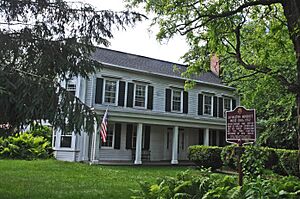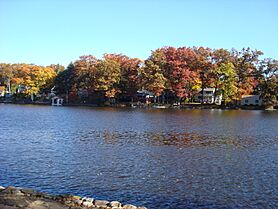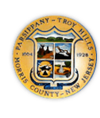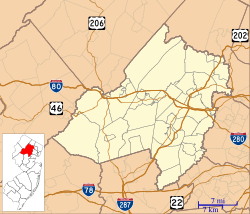Parsippany–Troy Hills, New Jersey facts for kids
Quick facts for kids
Parsippany–Troy Hills, New Jersey
|
||
|---|---|---|
|
Township
|
||
|
|
||
|
||
| Country | ||
| State | ||
| County | ||
| Incorporated | May 9, 1928 | |
| Government | ||
| • Type | Faulkner Act (mayor–council) | |
| • Body | Township Council | |
| Area | ||
| • Total | 25.35 sq mi (65.65 km2) | |
| • Land | 23.63 sq mi (61.20 km2) | |
| • Water | 1.72 sq mi (4.45 km2) 6.79% | |
| Area rank | 105th of 565 in state 6th of 39 in county |
|
| Elevation | 302 ft (92 m) | |
| Population
(2020)
|
||
| • Total | 56,162 | |
| • Estimate
(2023)
|
56,289 | |
| • Rank | 30th of 565 in state 1st of 39 in county |
|
| • Density | 2,376.5/sq mi (917.6/km2) | |
| • Density rank | 261st of 565 in state 13th of 39 in county |
|
| Time zone | UTC−05:00 (Eastern (EST)) | |
| • Summer (DST) | UTC−04:00 (Eastern (EDT)) | |
| ZIP Code |
07054
|
|
| Area code(s) | 973 | |
| FIPS code | 3402756460 | |
| GNIS feature ID | 0882206 | |
Parsippany–Troy Hills, often called Parsippany, is a township in Morris County, New Jersey. It's in the northern part of the U.S. state of New Jersey. In 2020, about 56,162 people lived here. This was a 5.5% increase from 2010.
The name Parsippany comes from the Lenape Native American tribe. It means "the place where the river winds through the valley." Parsippany–Troy Hills is the largest town by population in Morris County. The name Troy Hills was added to avoid confusion with mail sent to Troy, New York.
Parsippany–Troy Hills became a township on March 12, 1928. It was formed from parts of Hanover Township. Since 2006, Money magazine has often listed Parsippany–Troy Hills as one of the "Best Places to Live in the United States." It ranked 15th in 2022.
Contents
History of Parsippany
About 13,000 years ago, a huge ice sheet called the Wisconsin Glacier melted. This filled half of Parsippany with water, creating a large body of water known as Lake Passaic. The area was first a cold, grassy tundra. As it warmed, it became a forest with many trees.
Early Native American Life
Paleo-Indians first came to this area around 12,500 years ago. They traveled in small groups. They were drawn to the many different plants and animals here.
Later, other Native American groups settled in the highlands. They also lived along the Rockaway River and the Whippany River. They hunted and fished for animals that lived in or passed through the area. In the late 1970s, ancient paintings were found in a rock cave in western Parsippany.
Dutch and English Settlements
From 1611 to 1614, the Netherlands started a colony called New Netherland. This colony included all of northern New Jersey. Native Americans traded furs and food with the Dutch. They received items like metal pots, knives, and blankets. Trading stopped in 1643 when wars broke out between them. These conflicts made it hard for the Dutch to settle in what is now Morris County.
In 1664, English ships took control of New Netherland. Morris County then became part of the English Province of New York. Relations with Native Americans improved for a short time. After some back-and-forth control between the Dutch and English, the English finally took over for good. English settlers began moving to the Parsippany area around 1700. The flat land, good soil, and fresh water made it a great place for farming.
Slavery in Parsippany's Past
From the 1730s to the early 1800s, the area now known as Lake Hiawatha was a large slave plantation. It was called Beverwyck Plantation and covered 2,000 acres. The main street in Lake Hiawatha, Beverwyck Road, is named after a Dutch slave owner.
Many generations of African slaves were forced to work on this plantation. One person was Phebe Ann Jacobs, born enslaved in 1785. She later gained her freedom in Maine. She worked by laundering clothes for students at Bowdoin College. Her life story, published after her death, inspired Harriet Beecher Stowe to write Uncle Tom's Cabin, a famous anti-slavery novel.
Old records from 1768 mention a "Negro House" on the property. This building housed over 20 slaves, including skilled workers like a blacksmith and a shoemaker. Important historical figures like George Washington also visited the estate.
Geography and Climate
Parsippany–Troy Hills covers about 25.35 square miles (65.65 square kilometers). Most of this is land, with a smaller part being water.
Several smaller communities are part of the township. These include Greystone Park, Lake Hiawatha, Lake Parsippany, and Mount Tabor. Parsippany borders many other towns. These include Boonton, Denville Township, and Montville.
Weather in Parsippany
The township has a humid continental climate. This means it has cold winters and very warm summers. It is often cooler than New York City at night and in the mornings. The lowest temperature ever recorded was -26°F (-32°C). The highest was 104°F (40°C).
How the Land Was Formed
Parsippany–Troy Hills is in the Newark Piedmont Basin. About 500 million years ago, volcanic islands crashed into North America. This created the New York – New Jersey Highlands, which begin in western Parsippany.
Later, the North American Plate moved away from the African Plate. This created low-lying areas and valleys. The Ramapo Fault runs through the western part of the township.
When the Wisconsin Glacier melted around 13,000 BCE, it formed many rivers, streams, and lakes. Most of the township was covered by Lake Passaic. This was the largest lake in New Jersey at the time. As the lake drained, it formed swamps and meadows. These areas, like Troy Meadows, are now home to many different plants and animals.
Population and People
Parsippany–Troy Hills has grown steadily over the years. In 1930, about 6,631 people lived here. By 2020, the population had grown to 56,162.
The township is very diverse. According to 2022 data, about 47.8% of residents were White. About 37.2% were Asian. The largest Asian groups are people of Indian (25.6%) and Chinese (6.3%) backgrounds. About 8.4% of the population was Hispanic or Latino.
In 2010, about 30.9% of households had children under 18. Most households (58.3%) were married couples. About 25.0% of households were people living alone. The average household had 2.58 people.
Economy and Businesses
Parsippany–Troy Hills is home to many important companies. From 1967 to 2015, the Vince Lombardi Trophy for the Super Bowl was made here by Tiffany & Co. The Larry O'Brien Championship Trophy for the NBA Finals is also made here.
Many large companies have offices or headquarters in Parsippany. These include Allergan, B&G Foods, GAF Materials Corporation, Sun Chemical, and Zoetis. Other well-known companies like Lexus and Toyota Financial Services are also here. PNY Technologies, which makes computer memory, is located in Parsippany.
Several international food and consumer goods companies have their U.S. operations here. These include Cadbury Adams, Ferrero, Reckitt Benckiser, and Ricola.
Sports and Recreation
Parsippany has a soccer club called Parsippany SC. It has teams in the Super Y-League and the Super-20 League.
One of Parsippany's Little League baseball teams, Par–Troy Little League East, played in the 2012 Little League World Series. They made it to the third round of the tournament.
Government and Politics

Local Government
Parsippany–Troy Hills is run by a Mayor-Council system. This means there is a mayor and a five-member township council. Both the mayor and council members are elected for four-year terms. Elections happen in odd-numbered years in November.
The mayor is the chief executive. They prepare the budget and manage town departments. The council makes laws (called ordinances) and approves contracts.
As of 2025, the mayor of Parsippany–Troy Hills is Republican James R. Barberio. His term ends on December 31, 2025. He also served as mayor from 2010 to 2018. The Township Council includes Paul Carifi, Jr. (President), Frank Neglia (Vice President), Judy Hernandez, Matt McGrath, and Justin Musella.
Who Has Been Mayor?
Here is a list of mayors who have served Parsippany–Troy Hills:
- John E. J. Walsh (D) 1966
- Henry Luther (D) 1966–1974
- Jack Fahy (D) 1974–1982
- Frank Priore (R) 1982–1994
- Mimi Letts (D) 1994–2005
- Michael Luther (D) 2006–2010
- Jamie Barberio (R) 2010–2018
- Michael Soriano (D) 2018–2022
- Jamie Barberio (R) 2022–present
State and National Representation
Parsippany–Troy Hills is in New Jersey's 11th Congressional District. This means its residents vote for a representative in the U.S. House of Representatives from this district. It is also part of New Jersey's 26th state legislative district. This district elects members to the New Jersey State Senate and General Assembly.
Voting Trends
As of March 2011, Parsippany–Troy Hills had over 30,000 registered voters. About 23% were Democrats, 33% were Republicans, and 44% were not affiliated with a major party.
In the 2020 presidential election, Democrat Joe Biden received about 55% of the votes in Parsippany. Republican Donald Trump received about 43.5%.
Fire Protection Services
Parsippany–Troy Hills has six different fire districts. These districts operate out of ten fire houses across the township. Each district is its own fire department with its own Chief. All firefighters are volunteers and are on call all the time. The township police department handles dispatching for all fire calls.
Some of the fire departments include:
- District 1: Mount Tabor Fire Department (founded 1910)
- District 2: Rainbow Lakes Fire Department
- District 3: Lake Parsippany Fire Department (founded 1935)
- District 4: Lake Hiawatha Fire Department (established 1935)
- District 5: Parsippany District 5 Fire Department
- District 6: Parsippany – Troy Hills Fire District 6 (founded 1929)
Education System
Public Schools
The Parsippany–Troy Hills School District serves students from pre-kindergarten all the way through twelfth grade. The district has 10 elementary schools, 2 middle schools, and 2 high schools. It also has an adult education center. The students in the district come from many different backgrounds and cultures.
As of the 2021–22 school year, the district had about 7,082 students. There were 634.8 teachers, meaning about 11 students for every teacher.
The schools in the district include:
- Eastlake Elementary School (PreK–5)
- Intervale Elementary School (K–5)
- Knollwood Elementary School (K–5)
- Lake Hiawatha Elementary School (PreK–5)
- Lake Parsippany Elementary School (K–5)
- Littleton Elementary School (K–5)
- Mount Tabor Elementary School (K–5)
- Northvail Elementary School (K–5)
- Rockaway Meadow Elementary School (K–5)
- Troy Hills Elementary School (K–5)
- Brooklawn Middle School (6–8)
- Central Middle School (6–8)
- Parsippany High School (9–12)
- Parsippany Hills High School (9–12)
Private Schools
There are also private schools in Parsippany. All Saints' Academy teaches students from preschool to eighth grade. This school was formed in 2009 when two other Catholic schools merged. St. Elizabeth School offers Montessori education for children up to sixth grade. Both are Catholic schools run by the Roman Catholic Diocese of Paterson.
Transportation Options
Parsippany has many roads and highways. As of 2015, the township had over 208 miles of roads. Many major highways cross through Parsippany. These include Interstate 80, Interstate 280, and Interstate 287. Other important routes are U.S. Route 46 and U.S. Route 202.
Public Transit
Train service is available from the Mount Tabor station in nearby Denville Township. You can take NJ Transit trains on the Morris & Essex Lines to Penn Station in Midtown Manhattan or Hoboken Terminal.
NJ Transit also provides bus service to and from Newark. There are also local bus routes within the township.
Parsippany has its own bus system called Parsippany Transit. It's free for residents and runs on weekdays. You can also take buses from Lakeland Bus Lines to the Port Authority Bus Terminal in Midtown Manhattan.
The Morristown Municipal Airport, a smaller airport for private planes, is about 6.7 miles from Parsippany.
Famous People from Parsippany–Troy Hills
- Charlie Ayers (born 1966), a former head chef for Google.
- Joe Bernard (born 1963), a college football coach.
- Debbie Bramwell-Washington (born 1966), a professional bodybuilder.
- Darron Collins (born 1970), an expert in human ecology and plants.
- Clarence Curry (born 1981), a former NFL player for the New York Giants.
- Dillon Danis (1993/1994), a professional mixed martial artist.
- Bobby Darin (1936–1973), a famous singer and actor.
- Alex DeCroce (1936–2012), a politician who served in the New Jersey General Assembly.
- BettyLou DeCroce (born 1952), a politician who followed her husband in the General Assembly.
- Michael Dogbe (born 1996), a defensive end for the Arizona Cardinals.
- Bobby Edwards (born 1995), a soccer goalkeeper.
- Sherman Edwards (1919–1981), a songwriter known for the musical 1776.
- Keith Ferris (born 1929), an artist known for his B-17 mural at the National Air and Space Museum.
- Dean Gallo (1935–1994), a former U.S. Representative.
- Jessica Lee Goldyn (born 1985), a Broadway actress.
- Bill Hands (1940–2017), a Major League Baseball pitcher.
- Phebe Ann Jacobs (1785–1850), a person born into slavery whose story inspired Uncle Tom's Cabin.
- James Jean (born 1979), an award-winning artist.
- Danielle Jonas (born 1986), a reality TV star.
- Jane Krakowski (born 1968), an actress known for Ally McBeal and 30 Rock.
- Al Krevis (born 1952), a former NFL player.
- Steve Krisiloff (born 1946), a race car driver.
- George Kurtz (born c. 1970), a cybersecurity company CEO.
- Robert Lazzarini (born 1965), a sculptor.
- Fei-Fei Li (born 1976), a computer science professor at Stanford University.
- Nelson Lyon (1939–2012), a writer and film director.
- Paul Mirabella (born 1954), a Major League Baseball pitcher.
- Johnnie Morant (born 1981), a wide receiver for the Oakland Raiders.
- Edward Mosberg (1926-2022), a Holocaust survivor and educator.
- Jeff Okudah (born 1999), a cornerback for the Detroit Lions.
- Joe Orsulak (born 1962), a major league baseball player.
- Nimesh Patel (born 1986), a comedian and TV writer.
- Garrett Reisman (born 1968), a NASA astronaut.
- Zoogz Rift (1953–2011), a musician and artist.
- Joe Rigoli (born 1956), a baseball scout.
- Angelo Savoldi (1914–2013), a professional wrestler.
- Herb Scherer (1929–2012), a professional basketball player.
- UmaSofia Srivastava, who won Miss Teen USA 2023.
- Chris Singleton (born 1967), a linebacker for the New England Patriots.
- Tommy Vigh Jr. (born 1964), a race car driver.
- Richie Zisk (born 1949), a former major league baseball player.
Images for kids
-
Interstate 80 eastbound between Interstate 287 and Interstate 280 in Parsippany–Troy Hills
See also
 In Spanish: Parsippany-Troy Hills para niños
In Spanish: Parsippany-Troy Hills para niños













